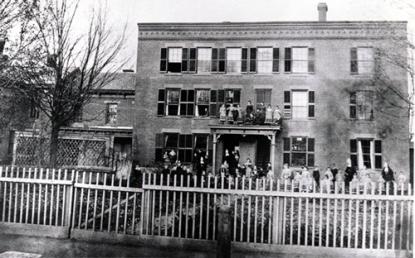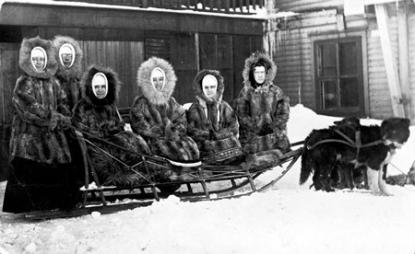
In 2007 I produced a documentary film, Faith in Providence: Women Religious in America, with the support of the Mass Humanities. This program examines the lives of women from a Catholic religious congregation in Massachusetts known as the Sisters of Providence of Holyoke. They are well known in Western Massachusetts for the myriad of health care institutions they established since arriving in Holyoke in 1873.
My work on this project was an opportunity to learn more about an area of women’s history– that of Catholic Sisters and their unique contributions to American society. Finding scholars that studied women religious was difficult. I was surprised to learn that none of the local women’s studies programs in the Five Colleges region delved into this area of study. Through my research I found Cynthia Russett, a historian at Yale University, who edited a book about the enormous contributions Catholic Sisters made to women’s higher education by founding colleges. I contacted Nancy Lusignan Shultz, an American Studies scholar who wrote a book about the burning of an Ursuline Convent in Charlestown in the early 1800s, by an anti-Catholic mob. I also went to St. Louis to interview historian Carol K. Coburn, who studies the lives of Catholic Sisters and wrote some excellent books on the subject. All these scholars and others were enormously helpful to me in recommending books and research avenues.
My first meetings and interviews with current Sisters of Providence left me feeling a deep admiration for those who devote their lives to helping others. They are an extraordinary and accomplished group of women, who are constantly looking for better and new ways to meet the needs of poor and disenfranchised persons. The Sisters feel it is their duty to help the most marginalized members of society. While they are astute businesswomen, they are not afraid to tackle difficult problems that are often fiscally draining, because there is a need. Healthcare programs for the homeless, methadone programs and a hospital for the severely mentally ill with physical disabilities: these are a few examples of their good works. What is striking to me is how innovative, entrepreneurial and flexible these sisters have been over the past 135 years in changing their mission to meet the current healthcare and social service needs of the community and finding creative ways to do this work.
I was very curious to learn how this group of Sisters differed historically from other congregations. I grew up Catholic and was taught by the Sisters of St. Joseph from first through twelfth grade, so I thought I knew quite a bit. The more I read about the works and lives of Sisters, the more I realized that I had no idea what these women collectively achieved and what obstacles they had to overcome. Even though I should have known better, I was guilty of believing both the good and bad stereotypes that exist in our culture about nuns.
The truth is, since the early nineteenth century, Catholic Sisters, either immigrant orders coming to America from France, Germany, Ireland and Canada (mainly) or new orders founded in America, like the Sisters of Charity, immediately set about helping the needy in whatever part of the nation they lived. Catholic clergy who were overwhelmed by their communities needs for healthcare and social services often invited them. This meant Catholic Sisters were often the first line of defense in nursing victims of war, epidemics and natural disasters regardless of their race, politics or creed. They also cared for orphans and the elderly, establishing orphanages and schools to teach immigrant children. They had to endure anti-Catholic prejudice and also often gender struggles with Bishops and the patriarchal Catholic Church.

Many of these women were entrepreneurial pioneers who were highly educated and devoted to their ministries: an uncommon set of accomplishments and commitments for women in the nineteenth century. For example, in 1856, Mother Joseph, a Sister or Providence from Montreal, with a small band of four sisters, traveled 6,000 miles to Fort Vancouver in the Washington Territory, where they made home visits to the sick and created homes for orphans. They immediately began raising funds by begging in mining and lumber camps in order to build hospitals and schools, which were at that time nonexistent. Mother Joseph, the daughter of a carpenter, assisted in the design and actual building of many of these structures. Along with the crucifix and beads of the traditional black habit, she frequently had a hammer dangling from her waist. She is memorialized in the National Statuary Hall in Washington DC partly because she built the first hospitals and schools in the Pacific Northwest.

Other women and men from many different faiths across the country also established or staffed many fine charitable institutions. For example, the Episcopalian Sisters of St. Margaret staffed the Boston Children’s hospital in 1850. But the sheer number of hospitals, schools, and orphanages established by over 300 Catholic orders was enormous. From the early nineteenth to the mid-twentieth century, these healthcare pioneers created the largest non-profit hospital system in the U.S., founding and staffing nearly 800 non-profit hospitals across the country.
The Sisters of Providence of Holyoke, like hundreds of other congregations of Catholic Sisters across the country, built orphanages, hospitals, schools of nursing, and homes for the elderly across Western Massachusetts. When they first came to Holyoke from Kingston, Ontario in 1873, they immediately welcomed orphans and abandoned elderly into their lodging, calling it the “House of Providence.” They went to the homes of the poor in the city to provide health care and assist with the dying. These women were entrepreneurs who raised the funds they needed to build charitable institutions by going on begging tours, holding bazaars, selling needle work and hand painted china, and other fundraising initiatives to come up with the needed capital. In 1880, two Sisters took a train out West to a mining region in Colorado and came back almost a year later with $6,000 they raised– by begging– to help pay for the area’s first orphanage in Holyoke, which was later known as Brightside.
By 1900, this small order of women religious had founded hospitals with the unanimous support from community members of different religious backgrounds in Holyoke, Springfield, Turners Falls, Worcester, and Pittsfield. They also staffed these hospitals and founded many of the first schools of nursing in Western Massachusetts. Additionally, the Sisters set up day care for working women, and low-cost housing for single working females.
I hope more scholars will choose to study women religious and bring the stories and truth about their contributions to society to light in the future.
A short clip from “Faith in Providence: Women Religious in America” can be found on its Internet Movie Database page.
PHOTOS, top to bottom:
(1) House of Providence (hospital) 1876 in Holyoke, MA; Courtesy of Providence Archives, Holyoke, MA
(2) Sisters Mary of Nazareth and Mary Conrad preparing to leave on a begging tour at St. Eugene Mission, Kootenay, British Columbia in 1896. Courtesy of Providence Archives, Seattle, Washington
(3) Sisters of Providence in Nome, Alaska 1918. Courtesy of Providence Archives, Seattle, Washington


